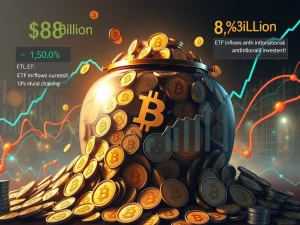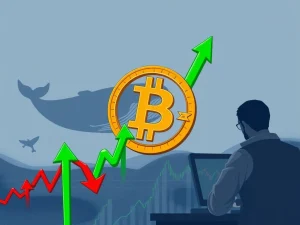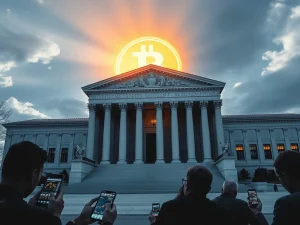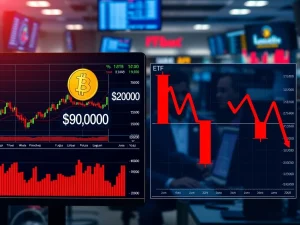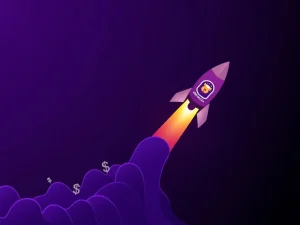Unveiling the Bitcoin Millionaire Myth: Why a $1 Early Bitcoin Investment in 2010 Was a Treacherous Path
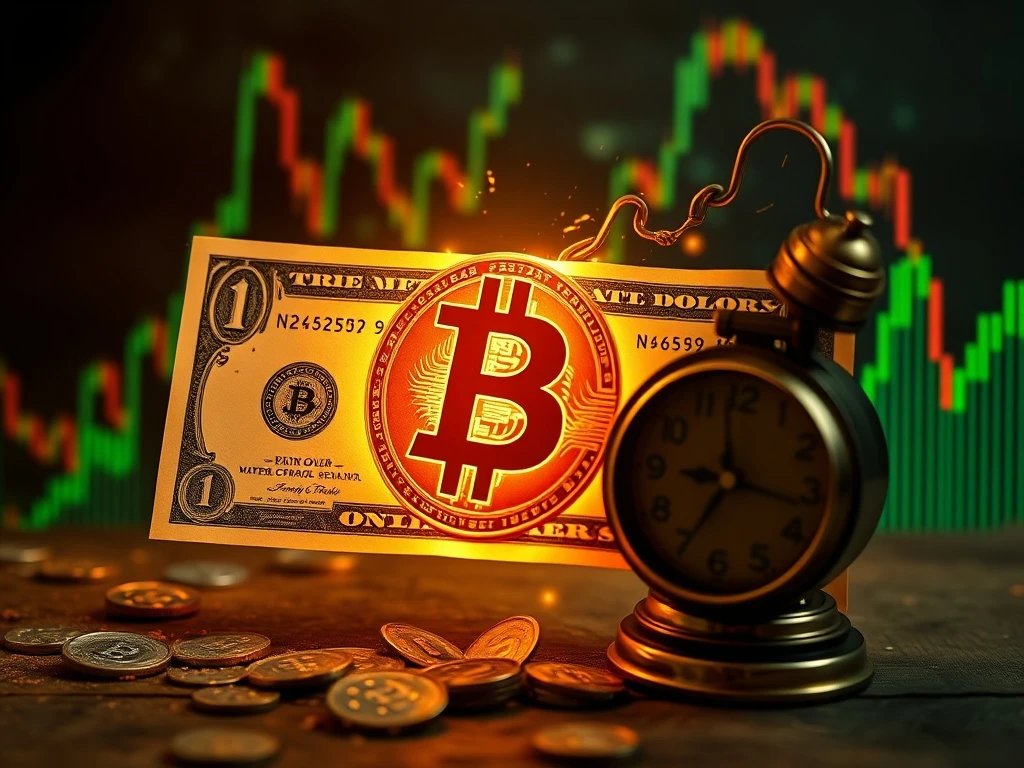
Many dream of becoming a Bitcoin millionaire. The fantasy often involves a simple time-travel scenario. Imagine buying Bitcoin for pennies in 2010. Then, you return to the present. Millions supposedly await in your account. This irresistible daydream captivates many. However, the reality of an early Bitcoin investment proves far more complex than this popular narrative suggests. It demands much more than just buying early.
The Enduring Bitcoin Millionaire Myth
In March 2010, the first recorded Bitcoin exchange price sat around $0.003 per Bitcoin (BTC). Prices never exceeded $0.40 that entire year. Today, BTC trades well into the six-figure range. This dramatic price increase fuels the Bitcoin millionaire myth. Yet, becoming a Bitcoin millionaire required immense resilience. Investors needed to build a substantial BTC position. They then had to hold it through multiple 80% to 90% price crashes. Exchange failures, like Mt. Gox, also posed significant threats. Shifting regulations and the constant risk of losing private keys added further pressure. Moreover, years of temptation to take “life-changing profits” tested even the strongest resolve. This article examines Bitcoin’s volatile past. It highlights headline-driven shocks and behavioral traps. The underlying math also makes this fantasy highly unlikely.
Navigating Bitcoin’s Extreme Price Volatility
Bitcoin’s journey from obscurity to six-figure valuations involved a series of sharp surges. These were often followed by brutal crashes. Many such events would have prompted even a cautious person to sell. Consider these historical milestones:
- 2010-2011: In January 2010, $1 could purchase about 333 BTC at roughly $0.003 each. By June 2011, Bitcoin peaked at $30. That same initial stash was then worth almost $10,000. Soon after, the price collapsed. The net value of those 333 BTC fell dramatically to about $666.
- 2013: The same stack later soared to roughly $88,000 at the $266 April high. It then plunged to over $16,500 by summer. By November’s $1,000 peak, your holding reached $333,000. This represented significant wealth at the time.
- 2014-2015: The Mt. Gox collapse severely impacted market confidence. The price dropped to around $150. Your stack consequently fell to almost $50,000. This period demonstrated extreme Bitcoin price volatility.
- 2017-2018: At approximately $20,000, your original $1 investment hit $6.66 million. However, by the 2018 low, it fell to about $1.13 million. While still substantial, this represented a steep drop.
- 2020-2022: COVID-19’s “Black Thursday” halved Bitcoin’s price in two days. The November 2021 all-time high of $69,000 pushed your stack to $22.98 million. It then slid to $5.29 million a year later.
- 2024-2025: In March 2024, Bitcoin reached a new all-time high above $73,000. This made your original dollar worth more than $24 million.
Surviving all this — the euphoria, the crashes, the scandals — presents a final challenge: Why would you sell now? Unrealized gains in Bitcoin resemble quantum superposition. They only “collapse” into reality upon selling. Until that moment, your millions exist merely as numbers on a screen. They remain hostage to Bitcoin’s next move. This constant fluctuation highlights the inherent Bitcoin price volatility.
Overcoming HODL Challenges and Behavioral Traps
The concept of “HODLing” (holding onto your cryptocurrency) seems simple. However, executing this strategy through Bitcoin’s tumultuous history presents enormous HODL challenges. Investors face constant psychological battles. The temptation to sell during parabolic rises is immense. Taking “life-changing profits” becomes a powerful urge. Conversely, during steep market crashes, fear often dominates. Panic selling can lead to significant losses. Many investors, even seasoned ones, succumb to these behavioral traps. Maintaining conviction through such extreme conditions requires extraordinary discipline. The journey demands a rare ability to ignore both euphoric highs and devastating lows. This mental fortitude is crucial for anyone hoping to replicate the success of early adopters.
Crypto Market Shocks That Tested Early Adopters
Not all selling pressure originated from price drops. Some of Bitcoin’s biggest tests came from news events. These events challenged even the most committed early Bitcoin investment holders. For example:
- Exchange Disasters: In 2014, Mt. Gox handled over 70% of global Bitcoin trading. It then revealed a loss of more than 650,000 BTC. Bankruptcy followed, wiping out thousands of early investors. In 2016, the Bitfinex hack saw over 119,000 BTC stolen. This understandably sparked fears of more exchange failures. The 2022 FTX collapse, then the second-largest crypto exchange, triggered a liquidity crisis. It also generated “crypto is dead” headlines across mainstream media.
- Crime and Stigma: The FBI’s 2013 takedown of Silk Road linked Bitcoin to illegal trade. This narrative took root in the public mind. Multimillion-dollar wallet seizures resurfaced for years. They fueled debate over Bitcoin’s perceived ties to crime.
- Policy Shocks: China repeatedly disrupted markets. Its 2013 banking ban caused panic. In 2017, it closed exchanges. A 2021 announcement made all crypto transactions illegal. Each event sparked fears of wider crypto regulation crackdowns. These crypto market shocks sent ripples globally.
- Forks: The 2017 blocksize debate, the Bitcoin Cash fork, and the abrupt SegWit2x cancellation divided the community. They raised questions about Bitcoin’s scalability and future direction.
Each of these moments forced investors to reconsider. Was holding worth the risk? Even with foresight and discipline, holding onto your original coins was never guaranteed.
The Unseen Danger: Losing Access to Your Early Bitcoin Investment
Even if you possessed the foresight to buy Bitcoin early, and the discipline to hold through every market crash, scandal, and policy shift, a real possibility remains: you might not still have your coins today. Bitcoin ownership is binary. You either control the private keys or you do not. Once lost, your fortune is gone. Lost coins represent a significant factor in the overall supply. Chainalysis estimates that 2.3 million to 3.7 million BTC are permanently out of circulation. These coins are locked in wallets with misplaced, destroyed, or inaccessible keys. Many belonged to early adopters. They often treated Bitcoin as a curiosity. They stored it on laptops or external drives. These devices were later wiped, recycled, or discarded.
One famous example is James Howells. This engineer from Newport, Wales, accidentally threw away a hard drive. It contained about 8,000 BTC, now worth hundreds of millions. He has spent years seeking permission to dig through a landfill to recover it. Even diligent holders were not immune. Coins stored on exchanges that later failed, such as Mt. Gox or QuadrigaCX, could disappear overnight. This removed “holding” from the owner’s control. In Bitcoin’s history, the greater danger often wasn’t selling too soon. Instead, it was losing access completely to your early Bitcoin investment.
The Reality for Those Who Did Achieve Bitcoin Millionaire Status
History shows almost no documented cases of the simple $1-to-Bitcoin millionaire myth by 2025. Instead, the following examples reflect scenarios that occurred far more often:
- Kristoffer Koch bought around 5,000 BTC in 2009 for $26.60. He later sold 1,000 BTC to buy an apartment. This happened years before Bitcoin’s biggest rallies.
- Stefan Thomas lost access to over 7,000 BTC (worth hundreds of millions today). This occurred due to a forgotten password for his IronKey.
- The Winklevoss twins became Bitcoin billionaires. They bought around 70,000 BTC with an $11 million lump sum in 2013. This was long after Bitcoin’s sub-$1 days.
- Li Xiaolai accumulated over 100,000 BTC. He made large purchases in 2011, not with spare change.
To summarize, Bitcoin fortunes were not made by a casual, buy-and-forget strategy with mere pocket money. They resulted from large early stakes. They required strict security practices. Exceptional discipline was paramount. The rare ability to endure both parabolic rises and severe crashes without panic selling proved essential. That is why the “time-travel millionaire” idea remains more myth than reality. The number of people who have lived through Bitcoin’s full price history while still holding their original stack is vanishingly small. The immense HODL challenges and constant crypto market shocks made this dream a near impossibility for most.

